4 Modern History: Change and conflict activities
1. Meiji Japan: Analysing historical perspectives and sources
Simon O’Rourke
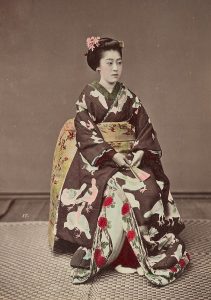
Seated Women (Meiji era Japan), Kusakabe Kimbei, Wikimedia Commons, Public Domain
| Curriculum context | VCE Unit 1 Modern History (VCAA, 2020) |
| Historical thinking concept/s | Use sources as evidence |
| Historical context | Meiji Restoration |
| Learning intentions | Identify the causes of the Meiji Restoration.
Analyse and infer the perspectives of Japan and the United States. Answer short-answer questions based on sources. |
Activity
Inquiry question: What were some of the perspectives on Commodore Matthew C. Perry’s arrival in Japan?
A) Introductory activity
Watch Samurai, Daimyo, Matthew Perry, and Nationalism: Crash Course World History #34
1-Minute Writing Recap
- In one-minute, write down as many points as you can about the Meiji Restoration in relation to the concept of nationalism.
- Share with your table group.
- Take one more minute to write down the new ideas as fast as you can.
- Share your ideas with the class and add to your notes.
B) Group task: Analysing perspectives
Source 1
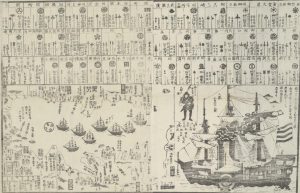
Japanese 1854 print relating Perry’s visit, Author Unknown, Wikimedia Commons, Public Domain
Source 2
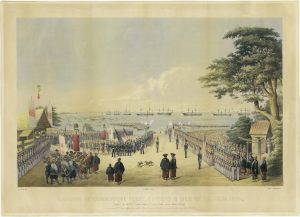
Commodore Matthew C. Perry’s visit of Kanagawa, near the site of present-day Yokohama on March 8, 1854 by Wilhelm Heine, Wikimedia Commons, Public Domain
Discuss the contrast between the two sources using the following prompts:
- Describe the content of each image.
- What is the historical context? Describe the event represented.
- Describe the way the groups of people and individuals are represented in source 2.
- Whose perspective is represented in each source? What can you observe in the source that gives evidence of this?
- What differing points of view or historical perspectives are represented?
- Why do you think the sources were created?
- How does your knowledge of events change how you understand the images?
C) Individual activity: Source analysis
Source 1
Read the excerpts in this source: ‘Excerpts from Shinron (New Theses): “The Barbarians’ Nature” by Aizawa Seishisai’, which was composed in 1825, 28 years prior to the arrival of Commodore Perry’s fleet.
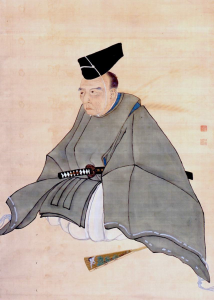
Portrait of Seishisai, Author Unknown, Wikimedia Commons, Public Domain
- From this excerpt, what is Aizawa’s perspective on the West?
- What does he consider the biggest threat from the West?
- What language does he use to steer us to his viewpoint?
Source 2
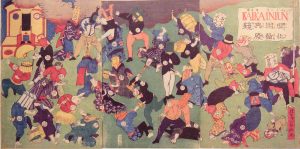
The New fighting the Old in early Meiji Japan, author unknown, Printing Museum News N36, Wikimedia Commons, Public Domain
Source 3
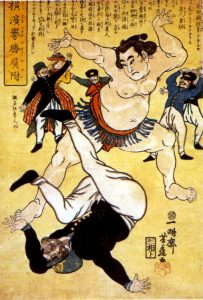
Sumo wrestler throwing a foreigner at Yokohama, Ippōsai Yoshifuji, Wikimedia Commons, Public Domain
- What views may have remained consistent from Aizawa’s time?
- How does source 1 challenge this view?
D) Small group activity: Source analysis
Source 1
President Millard Fillmore’s letter to the Emperor of Japan
- What proposal is President Fillmore offering?
- How would you describe President Fillmore’s intentions?
- How does this compare to Aizawa’s warnings from decades earlier?
Source 2
Translation of Japanese Reply to President Fillmore’s Letter
- What was the ‘imperative necessity’ that Moriyama mentions?
- What concessions to the original letter does Moriyama give?
- What could be meant by the exclusion of points made by President Fillmore?
Source 3
Commodore Perry’s letter to Senior Councillor Hayashi
- How does Commodore Perry react to the previous correspondence?
- What threat do you perceive from the letters?
- How would Emperor Tokugawa’s perspective have changed that allowed the opening of Japan?
Texting activity
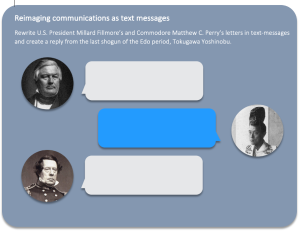
Portrait of Millard Fillmore, unknown photographer, Wikimedia Commons, , Public Domain (cropped from original image)
Yoshinobu in Osaka, The Japanese Book, Wikimedia Commons, Public Domain (cropped from original image)
Commodore Matthew Calbraith Perry, Metropolitan Museum of Art, Wikimedia Commons, , Public Domain (cropped from original image)
References
Asia for Educators (n.d.) Primary Source Document with Questions (DBQs) on Excerpts from Shinron (New Theses): “The Barbarians’ Nature,” By Aizawa Seishisai, Weatherhead East Asian Institute, Columbia University, accessed 16 July 2022.
Crashcourse (2022)_‘Samurai, Daimyo, Matthew Perry, and Nationalism: Crash Course World History #34’, CrashCourse, YouTube, accessed 10 July 2022.Facing History and Ourselves (n.d.) S-I-T: Surprising, interesting, troubling, Facing History and Ourselves, accessed 10 July 2022.
Visualizing Cultures (n.d.) President Fillmore’s letter to the Emperor of Japan, delivered July 14, 1853, MIT (Massachusetts Institute of Technology), accessed 16 July 2022. Green J (14 September 2012)
Victorian Curriculum and Assessment Authority [VCAA] (2020) VCE History Study Design, accessed 15 July 2022.
2. Reading between the lines: Frontier encounters in Australia
Chris Mayman
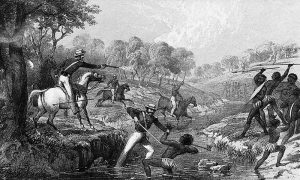
Tinted lithograph depicting the Waterloo Creek massacre by the New South Wales Military Mounted Police, by Godfrey Charles Mundy, Walton, W.L Bentley, Richard Hullmandel & Walton, Wikimedia Commons and AWM, Public Domain
| Curriculum context | Modern History Stage 1, South Australian Certificate of Education (SACE, n.d.) |
| Historical thinking concept/s | Ask and use historical questions |
| Historical context | Indigenous peoples > Colonial frontier massacres in Australia |
| Learning intentions | Identify key features in the ways settler society interacted with the Indigenous societies during the period of the colonial frontier.
Develop, understand and answer inferential questions using a range of resources. Demonstrate the ability to develop their own texts and transfer learning to others. |
Activity
In this activity, you will analyse police patrol reports and historical documents from the early days of settlement in Australia with special regard to the experiences of the Indigenous Australian population and draw conclusions about what these reports may have been implying.
You will split into small groups and between yourselves allocate those responsible for analysing the separate police report texts provided, as well as texts from more recent times that provide contemporary historians’ analysis of some of the terms and euphemisms used in the reports. The groups will use the two sources to develop an understanding of what may be inferred from these reports about the lives of the local Indigenous populations.
Each student in the group is to answer one of the questions below (150-200 words) and share their findings with the others in their group.
Sources
Source 1 Patrol of Stations in Timber Creek and Wave Hill Districts 1947
Source 2 Miscellaneous Reports 1946 – 1949
Source 4 Enforcing assimilation, dismantling Aboriginal families: a history of police violence in Australia
Source 5 Police interactions with Aboriginal people are scarred by Australia’s violent frontier history
Questions
- Using the information found in the patrol reports and historical documents, what reasonable inferences can be made about the attitudes of the settlers and the police toward Indigenous people?
- What impact might this have had regarding the pursuit of justice for Indigenous people in the area?
- What roles did Indigenous people play in the early settler societies of these regions? What influence do we think that could have on their ability to both integrate into settler society as well as achieve social mobility?
- What can we learn from these texts about Indigenous perspectives on the settler societies of these areas?
References
Anthony, T. and Blagg, H. (2020). Enforcing assimilation, dismantling Aboriginal families: a history of police violence in Australia.The Conversation, accessed 16 August 2022.
Daley, P. (2022). Police interactions with Aboriginal people are scarred by Australia’s violent frontier history, The Guardian, accessed 16 August 2022.
National Archives of Australia (2008) Patrol of Stations in Timber Creek and Wave Hill Districts 1947. Darwin: National Archives of Australia. Colonial Secretary’s Office, 2017. Indexes to correspondence relating to Aborigines and Torres Strait Islanders in the records of the Colonial Secretary’s Office and the Home Secretary’s Office, 1859 – 1896. Colonial Secretary’s Office Queensland, accessed 16 August 2022.
National Archives of Australia (2008) Miscellaneous Reports 1946 – 1949. Darwin: National Archives of Australia, accessed 16 August 2022.
SACE (n.d.) Modern History Stage 1 Indigenous peoples, South Australian Certificate of Education, accessed 16 August 2022.
3. The Sick Man of Europe: Using sources to explore the decline of the Ottoman Empire
Phillip O’Brien
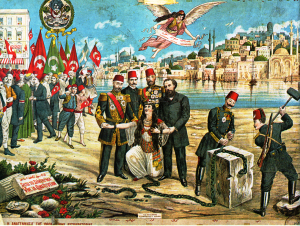
| Curriculum context | Unit 2 Modern History, Area of Study 1 (VCAA, 2020) |
| Historical thinking concept/s | Analyse cause and consequence
Identify continuity and change |
| Historical context | The end of empires and the emergence of nation states > The decline of the Ottoman Empire |
| Learning intentions | Use questions to focus source analysis.
Complete the provided questions and work with the linked sources. Identify internal and external forces that contributed to the decline of the Ottoman Empire. |
Activity
In this activity, you will explore the decline of the Ottoman Empire and the notion of ‘the Sick Man of Europe’ by using the provided framework to analyse a source. Once completed, you then have an opportunity to expand your understanding through further application.
Source Analysis
In order to use a source as evidence, historians must first conduct an evaluation of it, bearing in mind the following: What is the source? Who made it? When? Where? Why? It is vital to explore the content and purpose of the source. It is necessary to link the source to its historical context: time, place and location (VCAA, 2020:6).
| What is the source?
(Content) |
What information can be determined? What meanings are evident? |
| Who made it?
(Content) |
Who is the author? What point of view is evident here? |
| When/Where?
(Content) |
Where does the source come from? When was it made? |
| What is its context?
(Historical Context) |
What else was happening at the time the source was made? |
| Why was it made?
(Purpose) |
Who is the source likely made for? What is its purpose? |
a) Review Source 1 “Turkey Limited” to complete the following questions:
Content:
- How might you describe the gentleman pictured in the image? Use features from the source to support your description.
- What clues suggest that the Ottoman Empire is declining?
- Where was the source originally published?
- Is the source providing a Turkish or an external view of the decline of the Ottoman Empire? Use evidence from the source to support your answer.
Historical Context
- The Ottoman Empire of the late 19th Century was known by some as ‘the Sick Man of Europe’. Review the provided information and suggest three reasons why.
Purpose
- For whom was the source created? Who were the intended audience?
- What does the source suggest about the relationship between the Ottoman Empire and Britain, France & Russia?
b) The Tanzimat era was a period of reformation for the Ottoman Empire. Using the analysis framework, review Source 2: Greek Lithograph Celebrating the Ottoman Constitution.
References
Department of Education and Training (2022, March 17) Reading, interpreting and analysing History sources, accessed 25 July 2022.
Punch (1896/2019) Punch magazine – Turkey Ltd Wikimedia Foundation, accessed 5 July 2022.
Unknown (1908/2020) Greek Lithograph Celebrating the Ottoman Constitution, Wikipedia, Wikimedia Foundation, accessed 25 July 2022.
Wikipedia (2022) Sick Man of Europe, Wikimedia Foundation, accessed 5 July 2022.
VCAA [Victorian Curriculum and Assessment Authority] (2021) VCE History Study Design, accessed 5 July 2022.
4. Examining the Treaty of Versailles
Joni Stamatopoulos
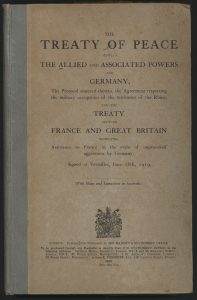
The Treaty of Versailles in English by David Lloyd George, Woodrow Wilson and Georges Clemenceau, Auckland War Memorial Museum Wikimedia Commons, Public Domain
| Curriculum context | VCE Unit 1 Modern History |
| Historical thinking concept/s | Exploring historical perspectives |
| Historical context | Post World War One ideologies; Treaty of Versailles. |
| Learning intentions | Identify the various ideologies key political figures represented during the Treaty of Versailles.
Evaluate significant events and how they impacted the first half of the 20th century. |
Activity
In this activity you will work in small groups to research significant individuals from the late 19th century and the first half of the 20th century in order to complete the character profile table . You will then use this knowledge to write a letter based on your selected individual following the Treaty of Versailles. It is important that you analyse significant events, characteristics, political agendas and ideologies when completing your table as this will greatly help in completing Part B. These activities will prompt you to think about the different perspectives of individuals following the first World War and provide insight into what may have caused World War 2.
Part A
Complete this table based on your selected key figure: Significant individuals and their contribution to political change by VCAA (n.d.) found in the drop down menu under Unit 1 Change and Conflict AOS1 Ideology: detailed example.
Part B
Put yourself in the shoes of your significant figure and imagine you are writing a letter that will be read at the Peace Conference. Using the source below for assistance, discuss how you feel with the decisions being made in the treaty, what you want from the treaty and what should be done to re-stabilise your country.
Source: The Versailles Treaty June 28th, 1919.
References
Lambert K, (2019) The Great War Evaluating the Treaty of Versailles, accessed 1 August 2022.
VCAA (n.d.) ‘Advice for Teachers History’, Victorian Curriculum Assessment Authority, accessed 1 August 2022.
VCAA [Victorian Curriculum and Assessment Authority] (2021) VCE History Study Design, accessed 1 August 2022.
Yale Law School (2008), The Versailles Treaty June 28, 1919 , The Avalon Project, accessed 1 August 2022.
5. Treaty of Versailles role play
Jett Mathews
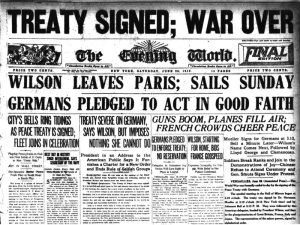
A newspaper article after the Treaty of Versailles was signed, Kallen2021, Wikimedia Commons, CC BY-SA 4.0
| Curriculum context | VCE Unit 1 Modern History (VCAA, 2020) |
| Historical thinking concept/s | Explore historical perspectives. |
| Historical context | The post-war treaties > The Treaty of Versailles |
| Learning intentions | Identify the various priorities and motives of the Treaty of Versailles.
Evaluate how terms from the Treaty of Versailles affected other individuals and countries. |
Activity
In this activity, you will participate in a role play of the Treaty of Versailles Peace Conference. The class will be divided into four groups: Britain, France, Germany or the United States. For the purpose of the role play Germany will be given a say and dismissed, though it is important to note Germany was not invited to the conference.
1. The groups will be given two resources. The first resource is their country’s profile that outlines their nation’s current circumstance, their leader’s stance on how World War I should be resolved and their main concerns going into the Treaty of Versailles.
Country profiles
FRANCE
Country’s circumstance
- France had experienced major infrastructural and land damage as a large portion of the war had been fought on the Western Front (on French land).
- A huge loss of agricultural land and population had hurt their economy and increased their need to import resources from other countries.
Prime Minister: Georges Clemenceau
- Nicknamed ‘The Tiger’ for his relentless approach.
- He believed Germany should be punished for their actions in World War 1.
- He wanted Germany’s military stripped of power to ensure France was not attacked again.
Priorities going into the Treaty of Versailles
- Germany must return the land of Alsace-Lorraine back to France which was taken from them in 1870.
- Germany to pay full reparations for the cost of the war.
- The Rhineland, which borders Germany and France, to be militarised with French troops protecting France from another German attack.
UNITED STATES
Country’s circumstance
- As the United States joined the war later than Britain and France, they did not endure the infrastructural or man damage than their counterparts.
- The country was in a great economical position and wanted Europe to be well positioned for trade.
Prime Minister: Woodrow Wilson
- Wilson advocated for world scale reforms to avoid another war.
- He believed Germany should not be punished harshly for their involvement in the war.
- Wilson created his Fourteen Points to reshape international relations.
Priorities going into the Treaty of Versailles
- Wilson wanted to accomplish on as many of the Fourteen Points as possible.
- His main aim was to establish an “international peacekeeping organisation” (Slavicek, 2010:44).
| 1. Open diplomacy without secret treaties 2. Economic free trade on the seas during war and peace 3. Equal trade conditions 4. Decrease armaments among all nations 5. Adjust colonial claims 6. Evacuation of all Central Powers from Russia and allow it to define its own independence 7. Belgium to be evacuated and restored 8. Return of Alsace-Lorraine region and all French territories 9. Readjust Italian borders 10. Austria-Hungary to be provided an opportunity for self-determination 11. Redraw the borders of the Balkan region creating Romania, Serbia and Montenegro 12. Creation of a Turkish state with guaranteed free trade in the Dardanelles 13. Creation of an independent Polish state 14. Creation of the League of Nations |
GREAT BRITAIN
Country’s circumstance
- Britain suffered a large number of military deaths in the war.
- Escaped major land damage due to the war being fought mostly on the Western Front.
- The country had acquired large debts due to the war.
Prime Minister Lloyd George
- Recently re-elected as Prime Minister of Great Britain.
- Lloyd George had promised the British public he would “squeeze the German lemon ‘til the pips squeak” (Slavicek, 2010:44).
- However, George also wanted Germany to be economically stable so the countries could continue to trade.
Priorities going into the Treaty of Versailles
- Britain’s naval supremacy to be protected by reducing the military size of Germany.
- Britain to receive Germany’s colonies.
GERMANY
Country’s circumstance
- Germany had been defeated after four wars of fighting.
- Germany is nearing an economic and social breakdown due to the war.
- Political unrest on the home front causes Kaiser Wilhelm II to abdicate as Germany becomes a republic.
Newly elected government: The Weimer Republic
- People back home believe the proposed terms of the Treaty are unfair.
- Unfortunately, if you resist the changes the Allies will go to war again.
Priorities going into the Treaty of Versailles
- Ideally would like the treaty to be based off Wilson’s 14 points.
- Unfortunately, they are at the hands of the Allies with no negotiation room.
2. The second resource is a “fill in the gap” speech, that the group will collectively finish and present to the other countries. Close analyse of the country profiles will allow the groups to complete their speech.
“Fill in the Gap” Speech
Good evening, my name is ____________ and I am the ______________ of ___________.
Here with me are my council.
We believe GERMANY / NO ONE should be blamed for the war.
Here are my country’s requests:
- In euros, Germany must pay a sum of €________________to make up for the cost of war. This because_____________________________________________________________.
- The German military SHOULD / SHOULD NOT be reduced because they _________________________________________________. The German army should be restricted to _________ men. The navy should only be allowed ___________ ship/s.
- Alsace Lorraine should be assigned to _________________ as _________________________________________________________.
- The Coalfields of Saar should be placed under the control of _________________ for ________________ years because _____________________________________________.
- Germany SHOULD / SHOULD NOT keep their colonies due to _______________________________________________________________________. These countries should be INDEPENDENT / LED BY __________________________.
- The Rhineland must be governed by _____________________ as ____________________________________________________.
We look forward to today’s proceedings.
_______________________________ (Unique farewell)
3. Once the groups have completed their “fill in the gap” speech, the class furniture will be arranged so that the four groups are facing each other with their countries place cards in front of them, replicating a conference. Germany’s group must present their speech first, however, since they were not actually invited to the conference in Versailles, they will be told their concerns are irrelevant. Germany is included in this activity as it is important to understand their ambitions from the Treaty.
4. After the speeches, your teacher will question the you on how each country’s main priorities affect their own. For example:
-
- What concerns do you share with France?
- Do you disagree with any of France’s requests?
- Is reducing Germany’s military fair?
5. At the end of the lesson, everyone will watch the video, ‘The Treaty of Versailles, Terms of the Treaty 2/2 and discuss the actual terms agreed upon in the Treaty of Versailles in 1918. Compare/contrast these terms with the decisions made during the role play.
References
Department of Education and Training (2022) Advice for Teachers – History, accessed 27 July 2022.
Mr. McDonald (n.d) Year 9 Simulation The Treaty of Versailles, School History, accessed 19 July 2022.
Simple History (2016) ‘The Treaty of Versailles, What Did the Big Three Want? 1/2’ YouTube, accessed 19 July 2022.
Simple History (2016) ‘The Treaty of Versailles, Terms of the Treaty 2/2’ YouTube, accessed 19 July 2022.
Slavicek, L (2010) Treaty of Versailles, Inforbase Learning, New York.
The National WW1 Museum and Memorial (2022) The Fourteen Points – Woodrow Wilson and the U.S Rejection of the Treaty of Versailles, accessed 30 July 2022.
Victorian Curriculum and Assessment Authority [VCAA] (2020) VCE History Study Design, accessed 15 July 2022.
6. Create your own political cartoon
Jett Mathews
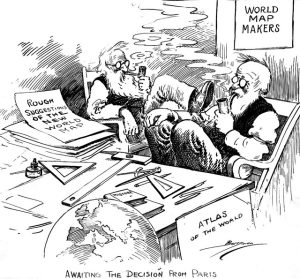
Awaiting the decision from Paris 1919, author unknown, Wikimedia Commons, Public Domain
| Curriculum context | VCE Unit 1 Modern History (VCAA, 2020) |
| Historical thinking concept/s | Use sources as evidence
Explore historical perspectives |
| Historical context | The post-war treaties > The Treaty of Versailles |
| Learning intentions | Interpret and explain history-specific details of political cartoons.
Identify and explain visual codes used in Treaty of Versailles cartoons. Understand why illustrators use different visual codes to convey their opinion. Create a Treaty of Versailles political cartoon that incorporates visual codes.
|
Activity
In this activity, you will work in pairs to research three political cartoons on the Treaty of Versailles. You will then analyse your selected political cartoons with a set of questions, which will challenge you to interpret how the images and text promote a political point of view/historical perspective.
After this activity, you will then create your own Treaty of Versailles cartoon. Finally, pairs are to swap cartoons and answer the set of questions again with another pair’s cartoon.
Political Cartoon Visual Codes
Caricature: “A picture, description, or imitation of a person in which certain striking characteristics are exaggerated in order to create a comic or grotesque effect” (Oxford Languages 2022).
Symbolism: “Cartoonists use simple objects, or symbols, that the general public would be familiar with. These symbols are used to represent important concepts or ideas” (History Skills, 2022). E.g., Cupid/Love, Skull/Death, Puppet/Being Controlled.
Stereotypes: Oversimplified characteristics which represent a person, race, or community (History Skills, 2022).
Captioning: Including information via an explanation in the cartoon (History Skills, 2022).
1. Find three political cartoons on the Treaty of Versailles but try to find sources that have differing points of view and illustrations.
2. Answer these questions for all three political cartoons.
- What individuals or groups are being displayed in the source?
- Identify two visual codes that are used in this cartoon and explain why are they included?
- What is the purpose of this carton?
3. Now create your own Treaty of Versailles cartoon using various visual codes.
4. Swap cartoons with a partner and answer questions above.
References
Department of Education and Training (2022) Advice for Teachers – History, accessed 27 July 2022.
Department of Education and Training (17 March 2022) Reading, interpreting and analysing History sources, accessed 27 July 2022.
History Skills (2022) How to interpret the meaning of political cartoons, accessed 21 July 2022.
Oxford Languages (2022) Caricature, accessed 21 July 2022.
Victorian Curriculum and Assessment Authority [VCAA] (2020) VCE History Study Design, accessed 15 July 2022.
7. The Treaty of Versailles: Using sources to explore the aims and outcomes of different leaders at the Paris Peace conference
Chloe Morrison
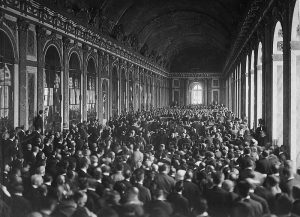
The delegations signing the Treaty of Versailles in the Hall of Mirrors, Helen Johns Kirtland and Lucian Swift Kirtland, Wikimedia Commons, Public Domain
| Curriculum context | VCE Unit 1 Modern History (VCAA, 2020) |
| Historical thinking concept/s | Use sources as evidence
Ask and use historical questions
|
| Historical context | Political and economic power, change and conflict > The Treaty of Versailles |
| Learning intentions | Use questions to focus source analysis.
Use questions to contextualise historical sources. |
Activity
In this activity you will explore and interpret some of the aims and outcomes of the Treaty of Versailles. In groups of two or three, using the framework provided as a guide, you will evaluate and analyse three political cartoons published in 1919 to explore the content and purpose of the sources in their historical context.
Source Analysis Framework
A source must be evaluated in its historical context to be used as evidence. Historians must question what, who, when, where and why the source was created to interpret its meaning, purpose and authenticity as evidence.
| What | What is the source? What meanings are evident? |
| Who | Who is the author/artist? What do we know about them? What point of view is evidenced in this source? |
| When | When was this source made? When/was this source published? |
| Where | Where was this source published or produced? |
| Context | What was happening at the time this source was made? |
| Why | What audience was this source created for? What was the purpose of this source? |
To assist your analysis you should consider:
- Who or what is represented in this cartoon?
- the use of caricature, symbolism, stereotype, analogy, captions and, labelling in cartoons
- the use of colour or shading
- details in the setting or background
- initial or immediate impression – Is this source a clear statement? An argument? A question or prompt?
- Review Source 1 and complete the following questions using the analysis framework as a guide.
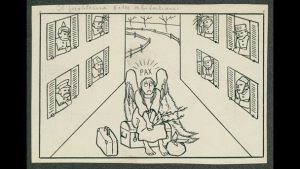
Source 1: ‘Peace’ 1918 British Library Public Domain
Content:
- Who are the people in the cartoon? How might you describe the people in this image – what does body language and facial expressions suggest?
- What clues tell you who or what is represented in this image?
- What story or narrative does the setting or background suggest?
Historical Context:
- 32 countries were represented at the Paris Peace Conferences. Why were these 8 people/countries represented in this image?
- List five reasons for the positioning of each character/representative in relation to the others. (e.g., Who is on the same side? Where are they looking? Are there any signs of unison in goals or are all parties represented as individually motivated – in which case, what seems to be the motivation?)
Purpose:
- What was the purpose of this source? Where do you think it may have been published?
- What does the source suggest of the aims of the victors for a post war world?
- Review Source 2 and complete a source analysis using the guide and your previous analyses.
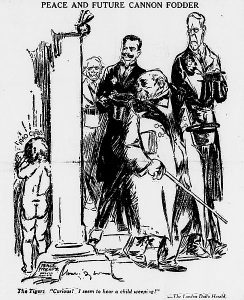
Source 2 ‘Peace and future cannon fodder’, Will Dyson, Wikimedia Commons, Public Domain
‘Peace and future cannon fodder’ is one of the best known and analysed cartoons from the immediate post war period. It is rich with material for analysis, including the wording in the caption, the title and images. Ensure you include links between the image and written analysis in your three to five paragraph response.
Optional Extension Questions:
“The great international expectation in 1919 was that after the ‘war to end all wars it might prove possible to construct a new world order based on the liberal outlook of the winners.” (Overy 2010:4)
1. What does the timeline of the production or publication of these three sources tell you about popular and/or shifting opinion of the Peace Treaties?
2. Write a two to three paragraph response, discussing your analysis of the three sources. Considering the historical context, what signs of an international view of optimism or pessimism are there during this period of time?
3. The following webpages and websites provide further assistance and guidance to support your analysis of primary sources and cartoons.
For further advice/assistance in your analysis, access and explore the following websites:
- Heritage of the Great War
- History Skills
- Spartacus Educational
- State Library of Victoria
- HTAV: Art reveals how Weimar and Nazi Cultures Diverged
References
British Library, All World War One Collection Items, accessd 31 July 2022.
Johnclare.net (n.d) Germany and the Treaty, UBRAT, accessed 19 July 2022.
National Museum of Australia (n.d) ‘Peace and future cannon fodder’ cartoon, by Will Dyson, May 1919
Australia’s defining moments, digital classroom, accessed 26 July 2022.
Victorian Curriculum and Assessment Authority 2020, VCE Study Design – History, VCAA, Melbourne
Department of Education and Training (2022) Reading, Interpreting and analysing History Sources, accessed 29 July 2022.
Victorian Curriculum and Assessment Authority [VCAA] (2020) VCE History Study Design, accessed 15 July 2022.
8. The Treaty of Versailles: Role play
Chloe Morrison
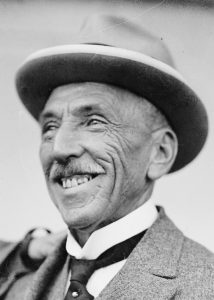
Prime Minister Billy Hughes 1919, Fairfax Corporation, Wikimedia Commons, Public Domain
| Curriculum context | VCE Unit 1 Modern History (VCAA, 2020) |
| Historical thinking concept/s | Explore historical perspectives
Construct historical arguments Identify continuity and change |
| Historical context | Change and Conflict, power and international relations > The Treaty of Versailles |
| Learning intentions | Identify and contextualise key ideas and features of significant events, individuals and movements.
Synthesise knowledge and questioning skills to identify and explore perspectives from different points of view. |
Activity
On June 28, 1919, 66 representatives from 32 different countries met in Paris to sign the Treaty of Versailles. The five Principal Allied and Associated powers of Britain, France, Italy, Japan and the United States made all of the major decisions in the creation of the treaty. Two delegates from each country met to define the peace terms of the treaty in what was known as the “Council of Ten” (later replaced by the “Council of Five”, made up of the respective foreign ministers).
(O’Neill A 2022, Statista)
In this role play activity you will start by drawing a role from from a hat. You will either be a representative of one of the five principal powers, an adjudicator, a minute taker, or scribe for the debate.
In groups of three or four, you will have time to research the position that your country was in at the end of the Great War and prepare to work with other world leaders to achieve a mutually beneficial outcome for your country. You will need to elect a Head of State in your group. The Head of State is the only team member allowed to vote. Other group members are delegates and civil servants.
Preparing for the role play
Your team will discuss and decide what outcomes you want from this settlement. You are limited to six motions that you may present to the delegation.
In your teams, you will prepare a series of motions that you wish to carry at the conference. In preparation you will need to consider:
- The systems of alliances and conditions which existed between European countries and throughout the world in 1914.
- Changes, costs, outcomes for your country resulting from the war.
- Changes, costs, outcomes for the other countries, in order to consider their likely goals and aims – are they likely to support your motion?
- Each motion must be seconded (supported) by another country before it can be passed to vote – some collaboration between heads of state is expected prior to the conference. There is no point wasting a motion if it has no secondary support.
- Any reparations or consequences you concede or expect from other countries.
- Racial, political, social attitudes and beliefs conditions of your country and internationally at the time. *
*Important note: This is an exercise requiring you to develop your historical skills in researching and the concepts of historical consciousness and empathy in context. You need to prepare and research deeply to ‘become’ the person or country you represent in 1919. Your challenge is to create a treaty without the benefit of 110 years hindsight, but from the position that your country or state was in at the time. (Why don’t you dress in costume appropriate to the times and person you represent to really immerse yourselves in character?)
The role play
There will be a world map projected on one white board that the scribe can annotate and refer to throughout the conference. A second large whiteboard will mirror the motions, minutes and results as they are taken by the minute taker. Each team will sit at a table for the proceedings. Motions will be passed to the chairman (teacher) and read in turn.
Any motion that assumes knowledge unavailable to the original participants you represent at the time, or assumes an attitude of mind inconsistent with the participants will be nullified. See debate rules.
Some websites to get you started:
- 40 Maps that explain World War 1
- A century later: The treaty of Versailles and its rejection of racial equality
- The Paris Peace Conference of 1919-1920 – A Yugoslav Perspective
- Exerts from Count Brockdorff-Rantzau’s Speech, May 7 1919
- National Archives: What did the different leaders want from the Treaty of Versailles?
- Signatories per country of the Treaty of Versailles
- Synopsis of obligations, including war aims of major powers
Watch:
References
Department of Education and Training (2022) Reading, Interpreting and analysing History Sources, accessed 29 July 2022.
National Archives (2022) Exerts from Count Brockdorff-Rantzau’s Speech, May 7 1919, accessed 29 July 2022.
National Archives (2022) What did the different leaders want from the Treaty of Versailles?, accessed 29 July 2022.
NPR (2019) A century later: The Treaty of Versailles and its rejection of racial equality, accessed 29 July 2022.
O’Neill A (2022) Treaty of Versailles: Signatories of the treaty, Statista, accessed 29 July 2022.
Victorian Curriculum and Assessment Authority [VCAA] (2020) VCE History Study Design, accessed 15 July 2022.
Vox (n.d.) 40 Maps that explain World War 1, accessed 29 July 2022.
9. Consequences of World War 1: The Treaty of Versailles
Nicholas Panagopoulos
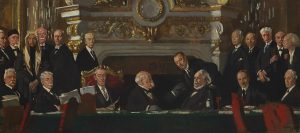 A Peace Conference at the Quai d’Orsay by Sir William Newenham Montague Orpen, Wikimedia Commons, Public Domain
A Peace Conference at the Quai d’Orsay by Sir William Newenham Montague Orpen, Wikimedia Commons, Public Domain
| Curriculum context | VCE Unit 1 Modern History (VCAA, 2020) |
| Historical thinking concept/s | Explore historical perspectives |
| Historical context | Inter-war years > Treaty of Versailles 1919 |
| Learning intentions | Identify the purpose and significance of one of the major causes of World War 2.
Consider the similarities in differences in perspectives of influential political figures. |
Activity
The Treaty of Versailles in 1919 was significant as it ended the state of war between Germany and the Allied Powers, however, not all delegates at the treaty saw eye-to-eye. Whilst the ‘Big Three’, Prime Minister of France Georges Clemenceau, President of America Woodrow Wilson, and Prime Minister of England David Lloyd George agreed war must never take place again, they did not agree on how this may take place and wanted different things from the peace treaty.
Individual Task
This activity encourages you to practise your skills in exploring historical perspectives by imagining you are one of the ‘Big Three’ at the Treaty of Versailles in 1919. For the purpose of this activity, you will each be assigned one of the ‘Big Three’ and your job is to write a 500 to 600 word journal entry in the weeks leading up to the peace treaty.
In your journal entry, you may take into consideration the following questions:
- What should happen to the entire Germany Army, including the air force and navy?
- How much should Germany pay in reparations (in damage done) for the war?
- Should Germany lose any territory? If so, how much?
- Should the treaty conclude that Germany is completely to blame for the war?
- How can we ensure a war such as this never takes place again?
As with every journal entry, please ensure it is written in first person and appropriately dated.
The following resources are good starting points to help you research the detail you need to write your journal entry:
- The Treaty of Versailles
- The Treaty of Versailles,
- Versailles Treaty
- Treaty of Versailles Explained – End of WWI 1919,
This activity also challenges you to use the internet to conduct your own investigation and research.
Optional Extension: You may look to extend your research and include the perspectives of the other leaders and/or the anticipated German response to the treaty in your journal.
Group Activity
Once your journal entries are complete, split into groups of three with each group having one of each of the ‘Big Three’. Discuss the similarities in historical perspectives and differences from your own analysis.
References
Boundless World History (n.d.) The Treaty of Versailles, History of Western Civilization (OER Services), accessed 25 July 2022.
Llewellyn, J & Thompson, S. (2017) The Treaty of Versailles, Alpha History, accessed 25 July 2022.
History Simplified (2021) Treaty of Versailles Explained – End of WWI 1919, You Tube, accessed 25 July 2022.
Spartacus Educational (2020) Versailles Treaty, Spartacus Educational, accessed 25 July 2022.
10. Analysing and evaluating sources from the roaring 20s
Monica Sheehan
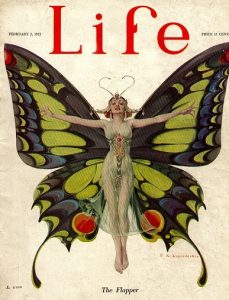
Life Flapper 1922, Cover by F. A. Leyendecker, Wikimedia Commons, Public Domain
| Curriculum context | VCE Unit 1 Modern History (VCAA, 2020) |
| Historical thinking concept/s | Use sources as evidence
Explore historical perspectives Construct historical arguments |
| Historical context | Between the world wars |
| Learning intentions | Analyse and evaluate different sources using the What? Who? When? Where? And Why? method described in the VCE History Study Design
Understand how evaluated sources can be used as evidence for historical arguments. Construct an argument relating to continuity and change within the 1920s. |
Activity
From the four sources below that were created in the 1920s, your task is to analyse and evaluate TWO of these sources relating to women’s lives in the 1920s. Then you will construct a historical argument containing your sources.
- The Flapper, cover of Life Magazine by Frank Xavier Leyendecker in 1922
- Otto Dix’s painting Metropolis painted in 1927
- Image of Peggy Petite a cabaret performer in 1927
- Image of La Folie du jour in 1927
Answer the following questions in relation to each source (Remember you only need to analyse two sources):
| Is this a primary or secondary source? Why? | What is the source? |
| Who made the source? | Who does the source portray? |
| When was the source made? | The historical context (time, place and location) |
| Where is the source portrayed? | Why was the source created? (VCAA 2020:6) |
| Is this source reliable? |
Once you have analysed and evaluated your two chosen sources you need to compare the two sources and think about these questions:
- How do these sources differ?
- Why do they have different historical perspectives?
- Do they have many similarities?
- How did the life and experiences of the main subjects of the sources change in the 1920s compared to each other? For example, Women? Men? Race?
These questions allow you to explore historical perspectives; remember to keep in mind the actions, beliefs, values and attitudes of people in the past as this is a major aspect of historical perspectives (VCAA 2020:6).
Using these questions and your sources, write two paragraphs to construct a historical argument addressing one of the following prompts in relation to your sources:
- To what extent did life for women change during the 1920s?
- World War I had a significant impact on all aspects of life for women. To what extent do you agree?
References
VCAA (Victorian Curriculum and Assessment Authority) (2020) VCE History Study Design, VCAA, Victorian Government, accessed 17 July 2022
Wiki Art (2020) Metropolis, WikiArt, accessed 20 July 2022.
Wikimedia Commons (2021) The Flapper, Media Wiki, accessed 20 July 2022.
Wikimedia Commons (2020) Cabaret artist Peggy Petite, Media Wiki, accessed 20 July 2022
Wikimedia Commons (2022) La Folie du jour, Media Wiki, accessed 20 July 2022
11. Source analysis activity: Women in the 1920s USA
Jessie Smith
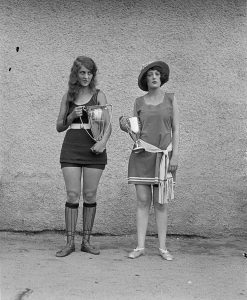
Beauty Show 1922, National Photo Company, Wikimedia Commons, Public Domain
| Curriculum context | VCE Unit 1 Modern History (VCAA, 2020) |
| Historical thinking concept/s | Ask and use historical questions
Explore historical perspectives |
| Historical context | Women in the 1920s in the United States |
| Learning intentions | Identify key events and themes relevant to women and their lives in the U.S.A in the 1920s.
Analyse the different perspectives and opinions about the social and cultural change experienced by women in the USA in the 1920s. Ask and answer substantive and procedural questions in relation to different sources. |
Activity
You will work in small groups to discover more about the context of women in the United States of America during the 1920s through primary source analysis. Firstly, you will read Source 1 and answer first order questions that will help build your knowledge on the modern woman and various movements/events that occurred in this era that contributed to a change for women in society.
You will then need to evaluate one of the additional three sources and answer both substantive knowledge (facts about the content being analysed, ‘what we know’ e.g., dates, names, quotes etc.) and procedural knowledge questions (concepts and skills, how do we know what we know? e.g., how, why, impacts of events etc) (Sharp et al. 2021:32). You will then present your findings to the class and the class will ask you additional substantive knowledge and procedural knowledge questions on a shared Google Doc.
You will need to research the answers to these, record in the Google Doc and present back to the class.
Part 1
Use Source 1 to answer the below substantive knowledge questions.
- What was the ‘modern woman’ referred to as and what were the characteristics of this type of woman?
- Who is Margaret Sanger and what is her significance to women in the 1920s?
- What was the Nineteenth Amendment and what is its significance?
Part 2
Pick one of the below sources and answer the following questions – you may conduct additional research if you wish.
- According to the newspaper entry, what are the characteristics of a flapper? Are there different types?
- How does this article and the way it is written suggest different attitudes towards the modern woman movement in the United States during the 1920s? Use quotes to support your answers.
- How did WWI contribute to this modern movement?
- What/who is Lowe referring to when she writes ‘illegitimate children’?
- Read the recommendations stated by Lowe, what does this suggest about the way women were viewed in society at the time?
- How do you think the Modern Woman movement would have responded to such recommendations?
- What is Bromley’s opinion of modern young women? Use quotes to support your answer.
- How does Bromley describe the ‘Feminism – New Style’ movement and how does this differ from the modern woman she is describing?
- Why do you think Bromley has these opinions?
Part 3
Each group will present their findings/answers from their source analysis. Using the Google Doc, formulate first and second order questions for the other groups in the class. Each group will research the answers to the questions asked of them and formulate responses in the Google Doc.
References
Bromley DD (October 1927) ‘Feminist – New Style’, Harper’s, The Ohio State University, accessed 26 July 2022.
Lowe C (October 1927) ‘Intelligence and Social Background of the Unmarried Mother’, Mental Hygiene, accessed 26 July 2022.
Open Stax College (n.d) The Jazz Age: Redefining the Nation, 1919-1929, Press Books, accessed 26 July 2022.
Page EW (6 December 1922) ‘A Flapper’s Appeal to Parents’, The Outlook, Old Magazine Articles, accessed 26 July 2022.
VCAA (Victorian Curriculum and Assessment Authority) (2020) VCE History Study Design, VCAA, Victorian Government, accessed 19 July 2022.
12. Flappers on Fakebook
Jessie Smith

Fakebook by Sean MacEntee 2010. (CC BY 2.0)
| Curriculum context | VCE Unit 1 Modern History (VCAA, 2020) |
| Historical thinking concept/s | Historical perspectives |
| Historical context | Women in the 1920s in the United States |
| Learning intentions | Use prior knowledge to articulate the perspective of a person in the 1920s in the USA.
Demonstrate how the perspective, activities, values etc of American society may have changed over the 1920s. |
Activity
In this activity you are going to apply historical perspectives to a contemporary communication tool. Your task is firstly to create a Fakebook (Class Tools n.d.) profile from the perspective of a person in the 1920s and create posts to be displayed on their timeline. Secondly, you will also need to create comments on your posts from different characters and include different perspectives. You may conduct additional research to assist you and revisit the themes observed over the unit and from the previous activity.
Examples of ‘characters’ you could create:
- Flapper woman
- Conservative person
- Parent of a flapper
- Partner of flapper
Requirements:
- The posts need to span over a minimum of a year, with a minimum of five posts.
- The posts can be text and can include copyright compliant pictures.
- Your posts need to address the changes experienced in the U.S.A at the time and the relevance of these changes to the individual making the posts.
- You will also need to demonstrate different perspectives by posting comments on your character’s posts..
Prompts to Assist You:
- Consider what year you will begin posting in – what was happening for women in society at that time and in society in general?
- What changes happened over this time period?
- How would these changes be reflected and experienced in different people’s lives?
- How do you think your characters would be reacting or behaving in response to societal changes or movements?
- When considering one person’s perspective, also consider the opposite perspective? How can you demonstrate these differences in your posts?
- Use images to tell the story.
References
Class Tools (n.d.) Fakebook, Class Tools, accessed 25 July 2022
VCAA (Victorian Curriculum and Assessment Authority) (2020) VCE History Study Design, VCAA, Victorian Government, accessed 15 July 2022.
13. Social change and women in the USA: Exploring historical perspectives
Sarah Jaeschke
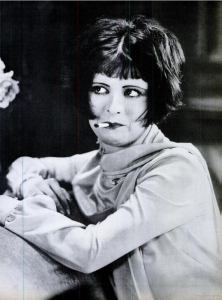
Promotional photo for motion picture Dancing Mother’s( 1926) Clara Bow as Catherine “Kittens” Westcourt, Famous Players-Lasky, Wikimedia Commons, Public Domain
| Curriculum context | VCE Unit 1 Modern History (VCAA, 2020) |
| Historical thinking concept/s | Explore historical perspectives |
| Historical context | The end of World War One ad the Roaring Twenties, focus on Western Society (USA and Australia). |
| Learning intentions | Actively draw on historical primary sources in a critical way.
Develop a level of understanding of the sources and how they relate to the changes in society for women in the context of 1920s America. Compare and contrast two sources and gain an understanding of the changes in society. |
Remembering the skills used and applied in understanding source analysis, students are to undertake a comparative analysis utilising the website Clash of Cultures. This site will help students understand and make comparisons and connections about the changing roles of women in the 1920s American context. Students can observe image and document analysis, keeping in mind the following when gaining an understanding;
- What is being presented in the document/image?
- Whose perspective is represented?
- Is there a message/motive/argument being presented?
Step 1: From the Clash of Cultures database, select two images or documents (or one of each). Try and aim for two opposing sources!
Step 2: Identify the title, date, and category of these sources in the table below.
Step 3: Fill in the table provided, this will help you in drawing similarities and comparisons from the two sources. The table will help you draw deeper connections between the experiences of women in the 1920s and the changes in society.
| Source 1 | Source 2 | |
| Title & Date | ||
| Category (as stated on website) | ||
| Image of the source |
|
|
| Provide a description of the source |
|
|
| What is the message of the source? What is the source saying? |
|
|
| Whose perspective is represented? |
|
|
| What can be understood about the context? What are the suggestions? |
|
Step 4: Based on your findings, what do Source 1 and Source 2 depict about the lives of women in 1920s American society? In your response, compare the two sources while thinking about the shifts and changes in society.
References
e History (n.d.) Clash of Cultures in the 1910s and 1920s Ohio State University, accessed 25 July 2022
VCAA (Victorian Curriculum and Assessment Authority) (2020) VCE History Study Design, VCAA, Victorian Government, accessed 15 July 2022.
14. League of Nations: Gathering information and analysing a source
Abby Kampl
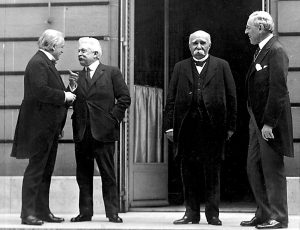
Big Four Paris, Edward N. Jackson (US Army Signal Corps), Wikimedia Commons, Public Domain
| Curriculum context | VCE Unit 1 Modern History (VCAA, 2020) |
| Historical thinking concept/s | Analyse sources as evidence
|
| Historical context | After the ending of the first World War > League of Nations |
| Learning intentions | Analyse the source by using the focus questions provided.
Explore the concept and context of the League of Nations. |
Activity
Information Gathering Activity
This activity is setting you up to create a poster based on the League of Nations. You will use the information collected here to create your poster. Within this activity there are questions that will guide you. There is also a source analysis to help further your analysis of the League of Nations. Sources have been provided for you to use during your activity, but you are free to expand your research and find information on your own.
Links to website for you to use:
- Britannica
- National Library of Australia
- Office of the Historian
- Alpha History
- Alpha History
- Parliament of Australia
- ABC News
Guiding Questions
- Identify the countries who were involved within the League of Nations. Identify the major countries, as well as influential individuals that were a part of the League of Nations.
- Describe the League of Nations.
- Explain the influence the League of Nations had on post-war life.
- How did the League of Nations affect the countries who were involved within it?
- Describe the effectiveness of the League of Nations.
- What did the League of Nations do that was significant?
- What topics did the League of Nations discuss and have a say in?
- How was Australia involved within the League of Nations and how was Australia impacted?
Source Analysis
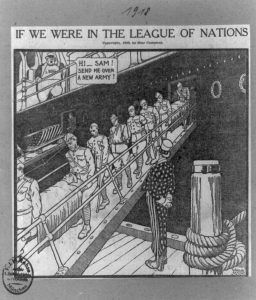
If we were the League of Nations, author unknown, Library of Congress, Wikimedia Commons, Public Domain
- Who are these figures and what country do they represent?
- How does the League of Nations seem to be affecting the countries represented?
- What does the positioning of these two figures suggest about who is in power?
- What event is the source portraying?
- This source is dated 1920, what was happening within the League of Nations at this time?
- What was happening within the post-war period when this cartoon was created?
References
ABC News (24 November 2018) How the League of Nations inspired Australia to raise its voice on foreign policy, ABC News, accessed 2 July 2022.
Alpha History (n.d.) Henry Cabot Lodge opposes the League of Nations (1919), AH, accessed 27 July 2022.
Alpha History (n.d) Woodrow Wilson Supports the League of Nations (1919), AH, accessed 27 July 2022.
Britannica (3 March 2020) League of Nations, Britannica, accessed 27 July 2022.
Library of Congress (n.d.) If we were in the League of Nations, LOC, accessed 22 July 2022.
National Library of Australia (n.d.) League of Nations Documents, NLA, accessed 27 July 2022.
Office of the Historian (n.d.) League of Nations, 1920, OH, accessed 27 July 2022.
Parliament of Australia (21 December 2018) Australia in the League of Nations: A centenary view, Parliament of Australia, accessed 27 July 2022.
PBS (n.d.) The League of Nations, PBS, accessed 4 August 2022.
Victorian Curriculum and Assessment Authority [VCAA] (2020) Victorian Certificate of Education History Study Design, VCAA, accessed 22 July 2022.
15. League of Nations: Informational slides
Abby Kampl
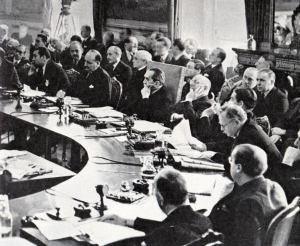
Australian Prime Minister, Stanley Bruce, at the League of Nations, Commonwealth of Australia, Wikimedia Commons, Public Domain
| Curriculum context | Unit 1 Modern History (VCAA, 2020) |
| Historical thinking concept/s | Establish historical significance |
| Historical context | After the ending of the First World War > League of Nations |
| Learning intentions | Choose a question and map out your poster.
Use your existing information to start creating your poster. Do some further research in order to fill in your poster. |
Activity
For this activity, you will use the information you have gathered from the last activity (see previous) to create informational slides based on one of the following questions. If you require more information, you can do some further research. The slides will be created on Google Slides; head to the slide that has your name. This way everyone can see each other’s slides in the end.
- What is the significance of the League of Nations?
- What were the consequences of the League of Nations?
- Using the source provided in the previous activity, use this as a starting point and explore the ideas it proposes about the League of Nations.
- Different countries had different views on the League of Nations. Explore the different views.
- Evaluate the effectiveness of the League of Nations.
- Choose a country that was a part of the League of Nations. What was their involvement and how did the League of Nations affect their country?
- Look at the first five years after the league of nations was formed and explore how political and economic conditions changed.
- Explore how Australia was involved within the League of Nations and the impact it had on Australian Citizens.
References
ABC News (24 November 2018) How the League of Nations inspired Australia to raise its voice on foreign policy, ABC News, accessed 2 July 2022.
Victorian Curriculum and Assessment Authority [VCAA] (2020) Victorian Certificate of Education History Study Design, VCAA, accessed 22 July 2022.
16. Analysing the successes and failures of the League of Nations using political cartoons
Chloe Goodie
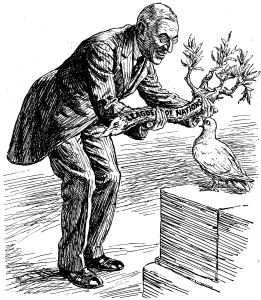
‘Here is your Olive Branch. Now get Busy’,(Punch Magazine 1919, author unknown, Wikimedia Commons, Public Domain
| Curriculum context | Unit 1: Change and Conflict, Modern History (VCAA, 2020) |
| Historical thinking concept/s | Use sources as evidence
Explore historical perspectives |
| Historical context | The consequences of World War One – successes and failures of the League of Nations. |
| Learning intentions | Answer historical questions in relation to sources.
Analyse chosen political cartoon using the question sheet. Describe and evaluate why and/or how the League of Nations successes and failures contributed to the ‘causes of World War Two’ and was a ‘consequence of World War One’ (VCAA 2022b:19).
|
Activity
In the discipline of history, historians evaluate drawings, images and political cartoons created in the past. Historical source evaluation involves ‘student[s] [undertaking] a process of source identification, attribution, contextualisation and close analysis’ (VCAA n.da.:Evaluation of historical sources). Analysing primary sources, provides historians a gateway into understanding the attitudes, perceptions, and values of the past (History Skills n.d.: para.1).
In this activity, in groups of three to four you will analyse one political cartoon to explore and evaluate the successes and failures of the League of Nations and how this event contributed to the development of World War Two.
1. I do: Your teacher will select a source to analyse with the students, modelling the key skills of analysing the image using the analysis questions.
Source Analysis Questions
| Origin | · When was the source created?
· Who created the source? · Where was the source created? |
| Content | · Name and describe the three features in the source.
· What is happening in the source? Who is depicted? |
| Context | · What was happening during the time this source was created? |
| Motive
(Llewellyn, Doone and Thompson 2017:para.5-7) |
· Why was the source created?
· What does this source say about the League of Nations actions and/or creation? |
2. We do: The whole class analyses a source together.
- Write down first initial thoughts about the image, stating what you first notice about the image.
- Using the question sheet, work through the questions together.
- Share points of view on the image and the the teacher will share own analysis and support this with evidence. (FHAO n.d.:Procedure).
3. You do: In groups of 3-4 choose an image from the recommended images below. Using the guide questions, analyse and evaluate the source’s context, content, origin, and motive regarding its depiction of the League of Nations successes and failures in contributing to the cause of World War Two (FHAO n.d.Procedure).
4. Share: Groups will then share with the class their findings about their chosen source, highlighting how the image depicts the League of Nations successes and failures and showcases the attitudes of those from the period.
Example political cartoons
2: ‘Here is your Olive Branch. Now get Busy’
3: ‘USA resists League of Nations 1919’
References
Facing History and Ourselves (FHO)(n.d.) Analyzing Images, FHO, accessed 27 July 2022.
History Skills (n.d.) Primary and Secondary Sources Explained, History Skills, accessed 27 July 2022.
Llewellyn J, Doone B and Thompson S (2017) Analysing Images, Alpha History, accessed 20 July 2022.
Victorian Curriculum and Assessment Authority (VCAA)(n.d.)(a) Advice for Teachers – History: Sample Approaches to developing am assessment task, VCAA, State Government of Victoria, accessed 20 July 2022.
—-(2022)(b)Victorian Certificate of Education: History Study Design – Accelerated Period 2022-2026, VCAA, State Government of Victoria, accessed 20 July 2022.
Wikimedia Commons (2010)(a) File: Punch dove and branch.png, Wikimedia Commons, accessed 27 2022.
—- (2013)(b) The Gap in the Bridge, Wikimedia Commons, accessed 27 July 2022.
—-(2022) File:USA resists League of Nations 1919.jpg, Wikimedia Commons, accessed 27 2022.
17. Researching and evaluating the credibility of digital secondary resources (websites)
Chloe Goodie

Photo by Sergey Zolkin Unsplash
| Curriculum context | Unit 1: Change and Conflict, Modern History (VCAA, 2020) |
| Historical thinking concept/s | Using sources as evidence
Ask historical questions |
| Historical context | The consequences of World War One – successes and failures of the League of Nations |
| Learning intentions | Search for five digital resources.
Use the acronym ‘RIGHT’ to judge whether the digital secondary source is relevant and credible (UWA 2022b). Analyse the source’s information and check whether it is considered credible and relevant. Order chosen sources from most credible to least credible.
|
Activity
Doing history, you encounter multiple types of sources both digital and print and primary and secondary. However, not all sources are credible and accurate. Historians must ensure they are using sources that are both relevant and accurate to help evaluate and analyse events, peoples, groups, and attitudes of the past.
Using credible online resources helps further support historical claims and helps academics avoid ‘reaching the wrong conclusions’ due to misinformed and inaccurate resources (UWA 2022b). As students of history it is important we use the ‘RIGHT’ sources and not ‘CRAAP ones’ (UWA 2022b).
In this activity you will search the internet and find five digital secondary sources (websites) about the League of Nations. After finding five sources, you will use acronym ‘RIGHT’ and questions provided to question the reliability and validity of the source (UWA 2022b).
RIGHT?
The University of Western Australia outlines (2022b), using the acronym ‘RIGHT’ helps students identify whether a source is reliable and worth using for research purposes.
R – ‘Relevant to your topic’ (UWA 2022b).
I – ‘Irreproachable* in a way that they are accurate and not flawed’ (UWA 2022b).
G – ‘Good quality resources that are authoritative and/or peer reviewed’ (UWA 2022b)
H – ‘Help to support the purpose of your research’ (UWA2022b).
T – ‘Timely relevance to your research’ (UWA 2022b).
* this means faultless
Evaluation Questions
- Who created the website? Are they an expert in the field? Are there any Bias?
- Is the source relevant to the topic of interest?
- Is the source published by a government agency, museum, library, universities, or archival institution?
- Can the website be edited by outside users?
- Find five secondary sources (at random) online concerning the successes and failures of the League of Nations.
- Using the acronym ‘RIGHT’ and questions above, analyse the credibility and relevance of information in the five chosen sources.
- After evaluating the five sources against the ‘RIGHT’ criteria acronym, rank the sources from most credible to least credible.
- Combine sources with a partner and rank them again.
References
History Skills (n.d.) Primary and Secondary Sources Explained, History Skills, accessed 27 July 2022.
University of Western Australia (UWA) (2022)(a) Sources for Historical Research: Secondary, UWA, accessed 27 July 2022.
—-(2022)(b) Evaluating information and Fake News: Welcome, UWA, accessed 27 July 2022.
VCAA (Victorian Curriculum and Assessment Authority) (2020) VCE History Study Design, VCAA, accessed 27 July 2022.
18. The rise of Nazism: Constructing an historical argument with evidence
Joel Lindeman-Collins
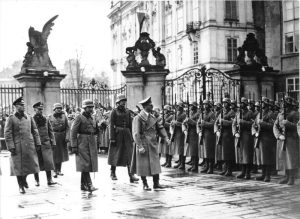
Adolf Hitler at Prague Castle, author unknown, Wikimedia Commons, German Federal Archives CC BY-SA3.0 DE
| Curriculum context | VCE Unit 1 Modern History (VCAA, 2020) |
| Historical thinking concept/s | Construct historical arguments
Use sources as evidence Identify continuity and change Analyse cause and consequence |
| Historical context | The Rise of Nazism in Germany (1930s) |
| Learning intentions | Understand the political, economic and social changes throughout Nazi Germany (1930s).
Understand how to analyse and use evidence in essay-style writing. Understand how to structure an history essay. |
Activity
Part 1
Complete the different steps of essay writing using the essay structure provided. Make sure to include the evidence sourced in other learning where necessary.
Task: Using the essay prompt below, complete the questions.
- Write a contention responding to the essay prompt. (Tip: Your contention will be your overarching argument and response to the prompt and should underpin your entire essay.)
- Think of three key ideas that support your contention and write them below. (Tip: Your key ideas will each be explored in the body paragraphs of your essay. For this piece you could dedicate one idea to each aspect of Nazi Germany society (political, social & economic)).
- Using your evidence, select one piece of evidence that supports each key idea chosen (Tip: You do not have to copy the entire piece of information. Only write down the key words that you may be able to use in your essay)
- Write a body paragraph focusing on one of your key ideas. (Tip: Follow the TEEL structure provided to ensure your paragraph flows correctly. Your writing should be in full sentences.)
T: Topic Sentence (restate your key idea)
E: Evidence (provide a piece of evidence that supports this key idea)
E: Explanation (explain the evidence and how it supports your key idea)
L: Link to Contention (explain how this idea supports your overall contention – link to next paragraph where possible)
5. Write a conclusion summarising your ideas and contention. (Tip: Do not introduce new ideas. Write three to four sentences explaining how your key ideas help to justify your contention.)
Part 2
Find another student and swap essays. Use the weather gauge model to provide each other with warm and cool constructive feedback.
Warm comments can be framed as statements that describe what your partner has done well and cool feedback can be framed as questions to prompt thinking about how the essay can be improved.
E.g. Warm feedback: “You have done a good job identifying a clear contention in your introduction.”
Cool feedback: “I wonder, how could you strengthen the argument in paragraph three by using supporting evidence?”
19. Fascism: Annotated timeline activity (part 1)
Kristiana Markovski
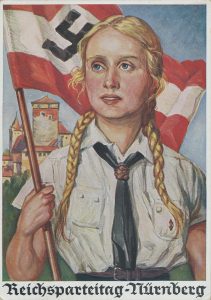
NSDAP Burg Propaganda Nazi Party Nuremberg Rally Postcard by Uncredited Illustrator, Wikimedia Commons (CC BY-SA 4.0)
| Curriculum context | VCE Unit 1 Modern History (VCAA, 2020) |
| Historical thinking concept/s | Analyse cause and consequences
Establish historical significance |
| Historical context | Fascism: Italy, Germany and Japan |
| Learning intentions | Identify and examine the significance of research concerning fascist ideology in Germany, Italy, and Japan.
Create an annotated timeline of propaganda in one of these nation states. Explain the causes and consequences of events, ideas and individuals contributing to fascist ideology in the inter-war period. |
Activity
You will be engaging in a Jigsaw-style task, where each student will be allocated one of three expert groups investigating fascism in either Germany, Italy, or Japan. Groups will be required to investigate and find examples of propaganda that were used during the inter-war period to promote fascist ideology. Groups will create an annotated timeline detailing the causes and consequences of events, individuals, and ideas present in their nation state.
Once the expert groups have completed their timelines, new groups will be formed with a mix of ‘expert’ students representing each nation, who will present their findings to the new group. These groups will discuss their findings and discuss the similarities and differences found in fascist propaganda between the nation states.
Students can use the following sources to help create their annotated timeline and are strongly encouraged to conduct their own investigative research:
Facing History & Ourselves – Germany
Libraries Exhibits – Italy
Chapman University – Digital Commons – Japan
References
Digital Commons (n.d.) Japanese Propaganda Posters, Chapman University, accessed 28 July 2022, https://digitalcommons.chapman.edu/japanese_propaganda_posters/
Facing History & Ourselves (n.d.) Gallery, Facing History & Ourselves, accessed 28 July 2022, https://www.facinghistory.org/resource-library/gallery/propaganda-posters
Libraries Exhibits (n.d.) Fascist Propaganda, University of Wisconsin-Madison, accessed 28 July 2022, https://exhibits.library.wisc.edu/special-collections/italian-life-under-fascism-selections-from-the-fry-collection/fascist-propaganda/
Victorian Curriculum and Assessment Authority [VCAA] (2020) VCE History Study Design, accessed 15 July 2022.
20. Create your own propaganda poster (part 2)
Kristiana Markovski
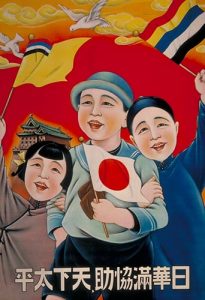
Propaganda poster of Manchukuo. The caption: “With the cooperation of Japan, China, and Manchukuo the world can be in peace.” Manchukuo State Council of Emperor Kang-de Puyi. Wikimedia Commons, Public Domain
| Curriculum context | VCE Unit 1 Modern History (VCAA, 2020) |
| Historical thinking concept/s | Use sources as evidence
Explore historical perspectives |
| Historical context | Fascism: Italy, Germany and Japan. |
| Learning intentions | Apply the fascist ideology research to create a propaganda poster for Germany, Italy, or Japan during the interwar period.
Analyse the significance and importance of propaganda during this time. Apply features of propaganda specific to these nation states to the creation of the propaganda poster. |
Activity
Utilise your knowledge of fascist propaganda from the previous activity to create your own propaganda poster. Identify and apply the specific features of propaganda found used by your group’s nation state. You could have a go at translating a slogan as well.
This site compares the use of imagery by different nation states: World War Propaganda Posters
Once complete, come together as a class, present your poster and have a go at analysing each other’s posters.
References
Wargaming.net (2022) World War Propaganda Posters, accessed 7 October 2022.
Victorian Curriculum and Assessment Authority [VCAA] (2020) VCE History Study Design, accessed 15 July 2022.
21. Social media ‘influencers’ in the lead up to World War II
Mason Camanzi
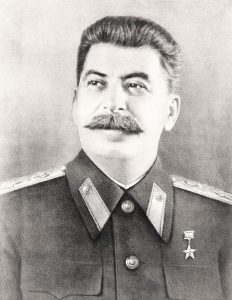
Iosif Stalin author unknown, Wikimedia Commons CC0 1.0
| Curriculum context | VCE Unit 1 Modern History (VCAA, 2020) |
| Historical thinking concept/s | Use sources as evidence |
| Historical context | Individuals who influenced political change leading into World War 2: Australia, Germany, Russia/USSR, Britain, and USA |
| Learning intentions | Create an “influencer” profile by engaging with primary and secondary sources of the individual.
Analyse sources for their significance. |
Activity
(Teachers Note: it may be beneficial to brainstorm names at the beginning of the task so students have a list of individuals they can choose from or, provide a list of individuals that you have studied throughout the area of study.)
You are to create a social media profile and post based on one of the significant individuals studied. Think about how these individuals could use social media to push their views, arguments and influence change.
The profile can look any way you wish and presented any way you wish. Think about what your favourite social media apps look like. You may like to use the provided template to guide your work.
In the social media profile, you will need to include:
- Two images found using reputable sources (from sources that are reliable). Explain the significance of these images (what does it tell us?)
- Two quotes from the significant individual that you can use as text posts. These can be written (letters, documents, etc.) or from a speech.
In making your profile, consider:
- Who they were, what did they do, when were they their most influential, where are they from?
- Why are the sources you selected significant?
- Counsell’s 5 Rs of historical significance (Counsell 2004:32):
- Remarkable
- Remembered
- Resulted in Change
- Resonant (Ripples)
- Revealing
- How do these sources show evidence of political change?
‘INFLUENCER’ Template
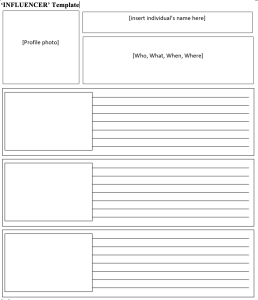
References
Counsell C (2004) ‘Looking through a Josephine-Butler-shaped window: focusing pupils’ thinking on historical significance’, Teaching History, 114: 30-33.
Victorian Curriculum and Assessment Authority [VCAA] (2020) VCE History Study Design, accessed 18 July 2022.
22. Source analysis group task: Pre-World War II Europe and the USA
Mason Camanzi
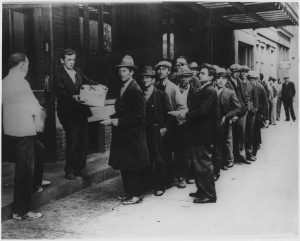
Depression: Breadlines,long line of people waiting to be fed: New York City, author unknown, Wikimedia Commons, Public Domain
| Curriculum context | VCE Unit 1 Modern History (VCAA, 2020) |
| Historical thinking concept/s | Use sources as evidence
Construct historical arguments |
| Historical context | Pre-WWII Europe and USA, including ideologies, individuals, and causes of WWII |
| Learning intentions | Collaborate with peers to brainstorm ideas for exam style questions.
Answer exam style questions. Peer-assess to allow for the sharing of ideas and feedback on how to improve moving forward. |
Activity
In answering the questions, think of different aspects of the Area of Study, including:
- Consequences of WWI
- Significant ideologies that strengthened, challenged or weakened empires and/or nation states, such as:
- Self-determination
- Nationalism
- Militarism
- Nazism
- Isolationism
- Significant individuals who contributed to change
- Significant causes of WWII
Source 1: Long queue for food at a grocery store, Berlin, 1923, adapted from the German Government

Bundesarchiv, Schlange vor Lebensmittelgeschäft (Queue in front of grocery store), author unknown, Wikimedia Commons, CC BY-SA 3.0 DE
- Using Source 1 and your own knowledge, explain three significant causes of World War II in 1939. (5 marks)
- Using Source 1 and your own knowledge, demonstrate how the consequences of the Treaty of Versailles led to World War II. (5 marks)
- Discuss the historical significance of Source 1, and analyse how it depicts political and economic change pre-1939. (10 marks)
Source 2: Cartoon depicting Uncle Sam, who “Should have stayed home” from World War 1, 1919
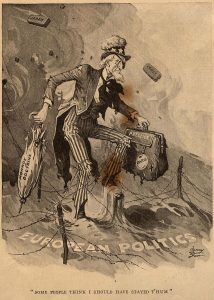
Uncle Sam should have stayed home, Dart, H G, June 26 1919, Wikimedia Commons, Public Domain
- Identify and describe the ideology depicted in Source 2 and analyse its impact moving into World War II. (5 marks)
- Using your own knowledge and Source 2, evaluate how ideologies challenged, strengthened and/or weakened political systems. (5 marks)
- Compare and contrast the USA New Deal and the Third Reich of Germany. In doing so, consider what the new political structures were aiming to achieve. Use Source 2 and your own knowledge (10 marks)
Source 3: British Prime Minister Neville Chamberlain’s “Peace in Our Time” Speech, 1938.
“We, the German Führer and Chancellor, and the British Prime Minister, have had a further meeting today and are agreed in recognizing that the question of Anglo-German relations is of the first importance for two countries and for Europe. “We regard the agreement signed last night and the Anglo-German Naval Agreement as symbolic of the desire of our two peoples never to go to war with one another again… My good friends this is the second time in our history that there has come back from Germany to Downing Street peace with honour. I believe it is peace in our time”
Source: Modern History Sourcebook: Neville Chamberlain: “Peace in our time”, 1938
- Using Source 3 and your own knowledge, explain the impact of the Munich Agreement and how it was a help or hinderance to “peace in our time”. (5 marks)
- There were many significant individuals who contributed to political change. Compare and contrast Neville Chamberlain and one other individual in how they made contributed to change, using Source 3 and your own knowledge (5 marks)
- Many peace treaties were signed post-World War I and pre-World War II. Using your own knowledge and Source 3, analyse the effectiveness of these treaties in maintain peace in Europe, including the Treaty of Versailles. (10 marks).
References
Chamberlain N (1938) ‘Peace in our time’, Modern History Sourcebook, accessed 2 August 2022
VCAA 2022 ‘Advice for Teachers- History’, Department of Education and Training, accessed 2 August 2022
Victorian Curriculum and Assessment Authority [VCAA] (2020) VCE History Study Design, accessed 1 August 2022.
23. Understanding ideology
Mia Treacey
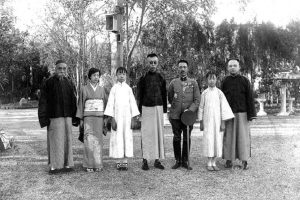
Puyi (last emperor of China) at the Zhang Garden in Tianjin or Japanese Legation Beijing Author unknown, Wikimedia Commons, Public Domain
| Curriculum context | VCE Unit 1 Modern History, AOS1 (VCAA, 2020) |
| Historical thinking concept/s | Explore historical perspectives |
| Historical context | WWI & WWII: France, Germany, Italy, Japan, Russia/USSR, Ottoman Empire/Turkey, the British Empire/United Kingdom, and the USA |
| Learning intentions | Define and explain ideology
Understand the difference between an ideology and a political system Identify ideologies relevant to the study of WWI and WWII Compare the ideological and political systems of key nations involved in WWI and WWII |
Activity
Essential question: What is an ideology, and what role did ideologies play in WWI and WWII?
PART 1: IDEOLOGIES
1. Provide a definition of each term listed in the table below.
2. Evaluate and indicate which terms are an example of an ideology.
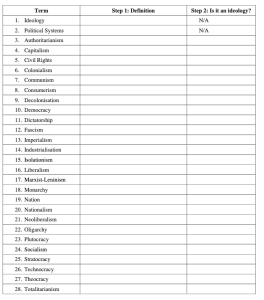
PART 2: COUNTRIES, POLITICAL SYSTEMS & IDEOLOGIES – WWI vs. WWII
1 WWI: For each nation – at the time of WWI – indicate what its ruling ideology and political system was and what its alliance was during the war.
2 WWII: For each nation – at the time of WWII – indicate what its ruling ideology and political system was and what its alliance was during the war.
Warning: some countries – change sides during a war, and others may not exist during a war!
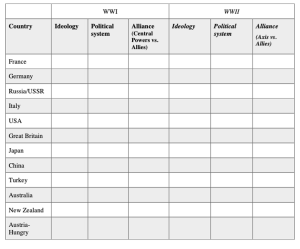
References
Victorian Curriculum and Assessment Authority [VCAA] (2020) VCE History Study Design, accessed 15 July 2022
24. Hexagon mind-map: Understanding inclusion and/or exclusion of groups from society
Monica Sheehan
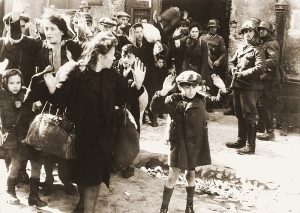
A Jewish boy surrenders in Warsaw, unknown author, Wikimedia Commons,
Public Domain
| Curriculum context | VCE Unit 1 Modern History |
| Historical thinking concept/s | Establish historical significance
Construct historical arguments |
| Historical context | Between the world wars |
| Learning intentions | Understand how to break down essay prompts
Be able to identify important events, dates, themes and evidence that are relevant to the prompt. Construct an argument about the significance of particular events |
Activity
This activity will allow you to shape your thoughts and ideas surrounding key methods and consequences of inclusion or exclusion of particular groups in society, particularly surrounding Germany and the Holocaust OR Stalinist Russia.
Step 1: You will receive pages of hexagon shapes. Inside these hexagon shapes, you are to write the key events, key themes, key dates and key evidence (you need to find these in your notes).
Examples of things you might like to put in your hexagons: Nuremberg Laws, Germany, Stalinist Russia, roles of women, inclusion, exclusion, Fascism, anti-Semitism, The Great Purge, communism, famine, The Holocaust, 1935, 1936-1938, Historical and/or Historian quotes.
You should use a highlighter to colour code your hexagons, for example, yellow for key events, blue for key dates, pink for key themes and green for key evidence

Step 2: Then you need to cut out your hexagons. This might take up a bit of time, but this exercise can be used repeatably for different purposes. YOU WILL NEED A PLASTIC POCKET TO STORE THE HEXAGONS SO THEY DO NOT GET LOST.
Move the hexagons around to make a honeycomb pattern by discussing the connections/relationships between them. See how many different honeycomb configurations you can make by identifying different connections.
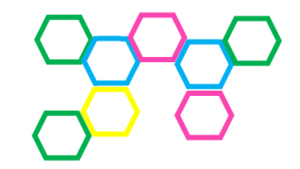
Step 3: Once you have done this, you can use the hexagons to map out an essay plan for one of the following topics:
- How did Stalin maintain and reinforce his power in the 1930s? Did this have an impact on particular groups? Discuss.
- What impact did the Nuremberg Laws have on antisemitic views in Germany?
- Discuss how women were perceived by the Nazis and incorporated into Nazi society. Did German women respond to Hitler and his program for them positively?
- Antisemitism underpinned many Nazi actions and policies during the 1930s. Explain how the Nazi regime attempted to extract German Jews from positions of influence. Use specific examples.
- Referring to specific examples, explain how propaganda promoted Nazi ideas about society, family and gender and how this impacted specific groups of people in the 1930s.
Start with a major theme or event hexagon and connect to all the hexagons with relevant details. Then discuss why you made those decisions with the people around you.
Using this plan, write the essay.
References
VCAA (Victorian Curriculum and Assessment Authority) (2020) VCE History Study Design, VCAA, Victorian Government, accessed 17 July 2022.
25. Ideology timeline
Jemima Stafford
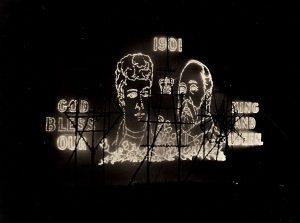
1901 Federation Celebrations in Brisbane – illumination of King Edward VII and Queen Alexandra, Aussie Mobs, Wikimedia Commons, Public Domain
| Curriculum context | VCE Unit 1 Modern History (VCAA, 2020) |
| Historical thinking concept/s | Identify continuity and change |
| Historical context | How significant ideologies change in the Twentieth Century |
| Learning intentions | Apply knowledge of ideologies
Work as a team Identify when dominant ideologies changed over time |
Activity
This activity will get you working in groups to map the dominant ideologies of various nation states at various times.
- A variation of countries will be written on the board; running horizontally across the board. These will include all nations mentioned in the curriculum: Britain, Australia, Germany, Italy, Russia, Turkey, Japan, India, America, China. Running vertically to the left of the countries will be years that you must use in order to place the given cards.
Board layout:
| Britain | Australia | Germany | Italy | Russia | Turkey | Japan | India | America | China | |
| 1890-99 | ||||||||||
| 1900-09 | ||||||||||
| 1910-19 | ||||||||||
| 1920-29 | ||||||||||
| 1930-39 | ||||||||||
| 1940-49 | ||||||||||
| 1950-59 |
- The ideology cards will have different colour coordinated ideologies on them (ranging of shades between red and blue to represent the ideas of right and left-wing ideology). They include:
- Socialism
- Communism
- Republic
- Democray
- Capitalism
- Dynastic
- Tsarism
- Totalitarianism
- Nazism
- The ideology cards must be placed on the board where your group believes each country went from one ideology to the next; for example, Russia moving from Tsarism to Socialism and so on.
Board layout:
| Britain | Australia | Germany | Italy | Russia | Turkey | Japan | India | America | China | |
| 1890-99 | ||||||||||
| 1900-09 | ||||||||||
| 1910-19 | ||||||||||
| 1920-29 | ||||||||||
| 1930-39 | ||||||||||
| 1940-49 | ||||||||||
| 1950-59 |
Here are some examples of what it might look like at some stage during the activity.
| Britain | Australia | Germany | Italy | Russia | Turkey | Japan | India | America | China | ||
| 1890-99 | Democracy | Tsarism | Democracy | Dynastic | |||||||
| 1900-09 | |||||||||||
| 1910-19 | Fascism | Socialism | Republic | ||||||||
| 1920-29 | Totalitarianism | ||||||||||
| 1930-39 | Totalitarianism | ||||||||||
| 1940-49 | |||||||||||
| 1950-59 | Democracy | ||||||||||
References
SparkNotes (2022) ‘Political Ideologies and Styles’, accessed 2 August 2022.
VCAA (Victorian Curriculum and Assessment Authority) (2020) VCE History Study Design, VCAA, Victorian Government, accessed 2 August 2022.
26. Germany and Italy cropped
Jemima Stafford
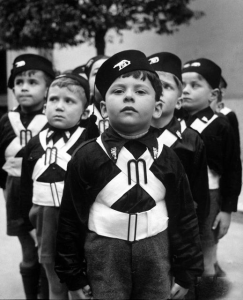
Ballilla-Italian Fascist Children’s Organisation, Author unknown, Wikimedia Commons, CC0 1.0
| Curriculum context | VCE Unit 1 Modern History (VCAA, 2020) |
| Historical thinking concept/s | Evaluation of historical sources |
| Historical context | Germany and Italy: unification, fascism and Nazism |
| Learning intentions | Analyse the visual components of an image with peers, using the crop technique |
Materials Provided:
Four enlarged primary source images split in two or four parts (depending on the image layout).
Directions:
- You will be allocated a group and given one section of a propaganda image (the whole images may be presented on the board for them to provide adequate context as well as the relevant information applicable to it OR your group can have a doing its section wothout seeing the other section).
- One student should be allocated as a scribe and another as a spokesperson for later in the activity.
- Students should consider imagery, connotations, language, other text, colour, symbolism, context of time, place and creator and how this all comes together within the source.
- Students that were allocated as spokesperson will present the different findings and these will be brought together with the other sections of the same source to provide a holistic analysis of the source.
- Group discussion prompt: What persuasive elements have been used within this piece of propaganda? What would make it successful? What was its intended message and purpose?
Source 1: ‘Behind the enemy lines: the Jew’, circa 1942 courtesy of Helmut Eschwege United States Holocaust Memorial Museum, Public Domain
Images provided to groups 1 and 2:
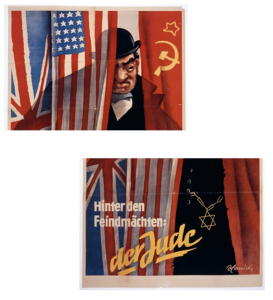
Source 2: “Remember the Maine! And Don’t Forget the Starving Cubans!”, American cartoon published in 1898 by Victor Gillam, Wikimedia Commons, Public Domain
Images provided to groups 3 and 4:
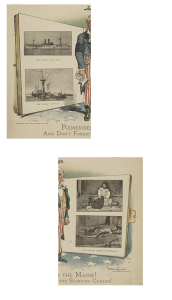
Source 3: L’Entente Cordiale: Alliance signed between United Kingdom and France, Library of Congress, Public Domain. Images provided for groups 5 and 6:
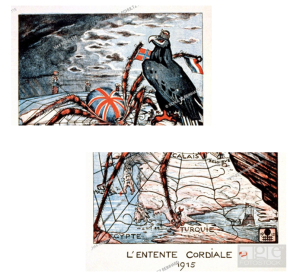
Source 4: , “The Attack”, propaganda against the Russification of Finland, 1899, by Edvard Isto, Wikimedia Commons, Public Domain.
Images provided for groups 7 and 8:
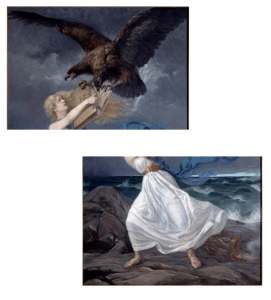
References
Facing History & Ourselves (2022), ‘Crop It’, accessed 28 July 2022.
VCAA (Victorian Curriculum and Assessment Authority) (2020) VCE History Study Design, VCAA, Victorian Government, accessed 28 July 2022.
27. Fishbone diagram: Causes of WWII
Steph Cahill
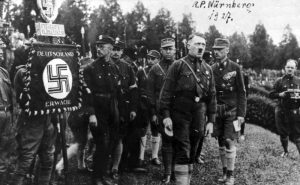
Photo of Adolf Hitler, Gregor Strasser, Rudolf Hess, Heinrich Himmler and at the Right the SA at the Nazi Party Rally Bundesarchiv, Bild 146-1969-054-53A, unknown author, Wikimedia Commons & German Federal Archive CC BY-SA 3.0 DE
| Curriculum context | VCE Unit 1 Modern History (VCAA, 2020) |
| Historical thinking concept/s | Analyse cause and consequence |
| Historical context | Emergence of Nazism and causes of WW2 |
| Learning intentions | Understand cause and effect
Identify key political and economic changes Identify the main causes of World War 2. |
Activity
This activity explores the factors that contributed to World War 2. Focusing on what we have discovered about the emergence of Nazism and how it swept over Germany, you will build a fishbone diagram which is also sometimes called a root cause diagram, in which you will be adding specific events accompanied by sources you believe to be directly linked to a key event or ideology that contributed toward World War 2.
In this activity you will be gathering your own research on the political and economic climate that contributed to major changes in relationships between nations and ideologies spread through states. This should be presented in the form of a journal of historical questioning that can be referred back to when needed.
To help us better understand cause and effect, utilise the following Historical Thinking website.
Whilst researching your cause-and-effect fishbone diagram, answer the following questions:
- What is the historical significance of this event/ideology?
- Who was involved?
- What do we know about this?
- What evidence do you have to support its significance?
- Does the chronology of the event/ideology have significance?
- What historical sources relate to this event/ideology?
References
The Historical Thinking Project (n.d.) Cause and Consequence, accessed on 3rd August 2022.
VCAA (Victorian Curriculum and Assessment Authority) (2020) VCE History Study Design, VCAA, Victorian Government, accessed 2 August 2022.
28. Causes and consequences of exclusion in the USA
Phoebe Thomas

African American primary school classroom 1930s, author unknown, Wikimedia Commons and Flickr Commons
| Curriculum context | VCE Unit 1 Modern History (VCAA, 2020) |
| Historical thinking concept/s | Cause and consequence |
| Historical context | Social life and cultural expression in the late nineteenth century and the first half of the twentieth century > Causes and consequences of exclusion in the USA. |
| Learning intentions |
Collaboratively identify the causes and consequences of exclusion in the USA. Collaboratively analyse the causes of the causes and the consequences of the consequences.
|
Activity
Part A
In small groups of three or four, research the causes and the consequences of exclusion of African Americans in the USA during the first half of the Twentieth Century. Use your findings to create a consequences wheel or use the cause and consequences diagram template below to that maps the cause and consequences of key events, ideas and policies. For example, you could start with a key cause in the middle of your wheel, such Jim Crow laws.
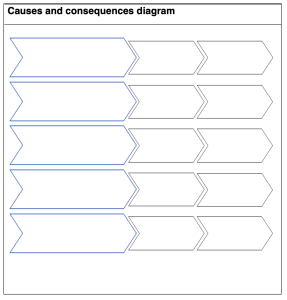
Part B
Pair up with someone in another group and use your both your wheels or diagrams to create a larger, more complex wheel or diagram.
References
QCAA (2018) Consequences Wheel, Queensland Government, accessed 16 July 2022
VCAA (2020) VCE History Study Design, Victorian Curriculum and Assessment Authority, accessed 16 July 2022
29. The Great Purge: Source analysis
Samantha Babic
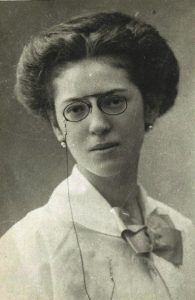
Pianist Khadija Gayibova, executed in 1938. Author unknown, Wikimedia Commons, Public Domain
| Curriculum context | VCE Unit 1 Modern History |
| Historical thinking concept/s | Use sources as evidence
Explore historical perspectives Use historical interpretations |
| Historical context | The Great Purge in Stalinist Russia |
| Learning intentions | Identify different elements of both written and visual sources to analyse and determine if they could be useful as historical evidence. |
Activity
Instructions
- Explore the different types of sources and their importance or how they can be used and analysed.
- Look at each source and annotate them with anything that stands out to you or that you notice as important or interesting
- Answer the below questions
- After answering the questions complete the similarities and differences table using the colour coding to determine which sources are being referred to.
Source 1: Leon Trotsky, The Trial of Seventeen (22nd January 1937), Spartacus Educational
“How could these old Bolsheviks who went through the jails and exiles of Czarism, who were the heroes of the civil war, the leaders of industry, the builders of the party, diplomats, turn out at the moment of “the complete victory of socialism” to be saboteurs, allies of fascism, organizer of espionage, agents of capitalist restoration? Who can believe such accusations? How can anyone be made to believe them. And why is Stalin compelled to tie up the fate of his personal rule with these monstrous, impossible, nightmarish juridical trials?
First and foremost, I must reaffirm the conclusion I had previously drawn that the ruling tops feel themselves more and more shaky. The degree of repression is always in proportion to the magnitude of the danger. The omnipotence of the soviet bureaucracy, its privileges, its lavish mode of life, are not cloaked by any tradition, any ideology, any legal norms.
The ruling caste is unable, however, to punish the opposition for its real thoughts and actions. The unremitting repressions are precisely for the purpose of preventing the masses from the real program of Trotskyism, which demands first of all more equality and more freedom for the masses.”
– Leon Trotsky, The Trial of Seventeen (22nd January 1937)
Source 2: Lenin’s General Staff of 1917: Stalin the executioner alone remains from Socialist Appeal October 1941
Source 3: The Great Terror by Lewis Siegelbaum, Seventeen Moments in Soviet History ** historical interpretation/secondary source**
“What had begun as bloody retribution against the defeated political opposition developed as a self-induced pathology within the body politic. Its psychic consequences among the survivors were long-lasting and incalculable.” – Lewis Siegelbaum
Source 4: Choose a primary source from The Great Terror Images.
Guiding questions
Identify the type, origin and content of the sources
- Who made it? (who is the author? What is their link to the topic? What is their perspective?)
- What type of source is it? (visual or written)
- When and where? (When was it made? Where did it come from? Outside or inside perspective?)
Describe the context of the sources and explain the purpose, using additional and supporting historical knowledge
- What is its historical context? (What else do you know about what was happening at the time it was made?)
- What was the purpose of this source?
Evaluate the usefulness of the source in understanding continuity and change or causes and/or consequences and/or significance.
- Is this source useful as historical evidence, why or why not?
(VCAA n.d.: ‘Evaluation of historical sources’)
References
Spartacus Educational (2021) The Great Purge, accessed 29 July 2022.
VCAA (2020) VCE History Study Design, Victorian Curriculum and Assessment Authority, accessed 29 July 2022.
Socialist Appeal (1941) Lenin’s general staff of 1917: Stalin the executioner alone remains, FLIPHTML5, accessed 29 July 2022.
Seventeen Moments in Soviet History (n.d.) The Great Terror , accessed 29 July 2022.

